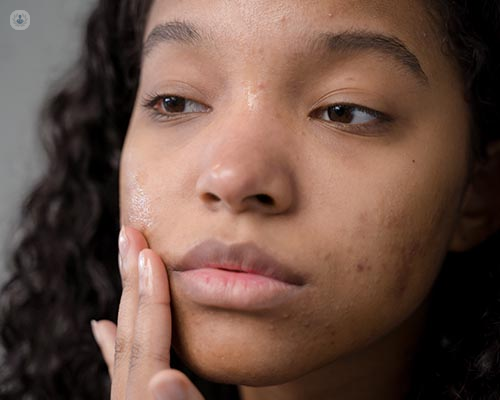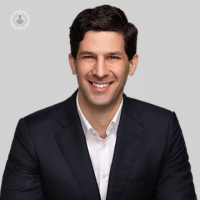What is acne and why does it happen?
Escrito por:Acne is a common skin condition that affects people of all ages but is particularly prevalent among teenagers and young adults. It occurs when hair follicles, or pores, become blocked with oil (sebum), dead skin cells, and bacteria. Sebum is a natural oily substance produced by sebaceous glands to keep the skin hydrated. However, when produced in excess, it can mix with other materials and clog the pores. This leads to inflammation and the development of spots, blackheads, whiteheads, and sometimes more severe lesions like cysts.
We speak to a leading dermatologist who explains the various types, management options and lifestyle options which can control it.

What triggers acne?
The primary triggers of acne are hormonal changes, which explain why it often begins during puberty. Hormones called androgens increase during this time, causing the sebaceous glands to enlarge and produce more oil. Other factors, such as stress, certain medications, and genetics, can also play a role.
What are the different types of acne?
Not all acne is the same, and understanding its various forms can help you identify what you may be experiencing. The most prevalent types of acne are:
Blackheads (open comedones): These are small, dark spots that appear when pores are partially clogged. The dark colour is not dirt but rather a result of oxidation when the contents are exposed to air.
Whiteheads (closed comedones): These are small, flesh-coloured or white bumps caused by completely clogged pores.
Papules: These are small, red, and tender bumps that indicate inflammation.
Pustules: These are similar to papules but contain pus at their tips, giving them a yellow or white centre.
Cysts and nodules: These are larger, painful lumps that form deeper under the skin. Cysts contain pus, while nodules are solid. Both are more severe and can lead to scarring.
How can you manage and treat acne?
The good news is that acne can be managed with the right approach. For mild to moderate acne, over-the-counter treatments are often effective. These include products containing ingredients like benzoyl peroxide, which reduces bacteria and inflammation, or salicylic acid, which helps exfoliate the skin and unclog pores. It's important to use these products consistently and as directed, as results may take several weeks to become noticeable.
For more persistent or severe acne, consulting a healthcare professional is advisable. A doctor or dermatologist may recommend prescription treatments, such as topical retinoids, antibiotics, or hormonal therapies. In cases of cystic acne, oral medications like isotretinoin may be considered, though this requires careful medical supervision.
Can diet and lifestyle affect acne?
While diet is not the sole cause of acne, certain foods may exacerbate it in some individuals. High-glycaemic foods, such as sugary snacks and refined carbohydrates, are thought to trigger breakouts by affecting blood sugar levels and hormone production. Additionally, dairy products have been linked to acne in some studies, particularly in those prone to skin issues.
Maintaining a healthy lifestyle can also support clearer skin. Regular exercise, stress management, and proper skincare routines play a crucial role. Gentle cleansing twice a day with a mild, non-comedogenic cleanser (meaning it won’t clog pores) can help keep the skin clean without over-drying it.
Should you squeeze or pick spots?
It can be tempting to squeeze or pick at spots, but this can worsen the problem. Picking can push bacteria and debris deeper into the skin, leading to further inflammation, infection, and potential scarring. Instead, allow spots to heal naturally or seek advice from a professional for safe extraction methods.
With the right treatment and care, improvement is achievable, and your skin can feel healthier over time


